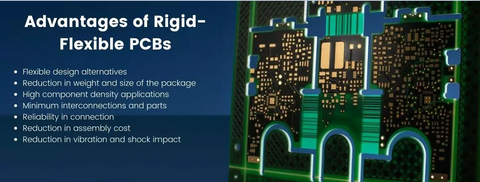
- Flexible design alternatives: The Flexible circuitry in a rigid-flexible PCB accepts any connector or component that could be assembled into a rigid printed circuit board design that supports high complex configurations. Where extra support may be required, the designs become rigid and are flexible around sections and corners that require much space.
- Reduction in weight and size of the package: The combination of flex circuits and rigid boards enables you to simplify your design and produce a package that is reduced in weight and size. You will be able to create circuitry that fits your device rather than the opposite.
- High component density applications: Industrialists and manufacturers are under pressure always to integrate more premium technology in little space and material. High component density in rigid-flexible PCBs is necessary for certain applications where the use of rigid and flexible circuits separately are unable to accomplish the project requirements. Controlled impedance rigid-flexible PCBs design (which offer a consistent performance of high frequency) circuitry support devices made of lightweight conductors with high-component density, thereby creating space for many product features.
- Minimum interconnections and parts: Compared to regular circuit boards, rigid-flexible PCBs need fewer connections, parts, and less assembling of the connectors. This increases productivity.
- Reliability in connection: Fewer interconnections minimize various potential sources of error, which in turn increases reliability.
- Reduction in assembly cost: With fewer connections and parts, assembly and purchase costs are reduced. This also helps to eliminate the risks that may occur within your product supply chain. It is advisable you carry out a feasibility study of the prototype to reduce the time for the development of a product and significantly minimize the product’s costs of production.
- Reduction in vibration and shock impact: Electronic components which are heavy may experience vibration and shock as a result of mechanical resonance. However, with rigid-flexible PCBs, you don’t have to be worried about such problems as rigid-flex PCBs are able to resist high temperature, radiation, heat, shock, and other tough conditions.
Applications Of Rigid-Flexible PCBs
The growing trend of miniaturizing or reducing electronic systems and devices requires high-quality flexible PCBs. And rigid-flexible PCBs are an integral part of this, which has made rigid-flexible PCBs become increasingly popular in the technology market. Several of the advantages of rigid-flexible PCBs discussed in the previous section that made them more popular has earned rigid-flexible PCBs numerous applications in the commercial and industrial market from little consumer products such as multimedia players and phones to advanced avionics/military systems.
Applications of rigid-flexible PCBs include:
- Medical industry-Handheld monitors, pacemakers, cochlear implants, imaging equipment, wireless controllers, and others.
- Manufacturing of military equipment-Communication systems, weapon guidance systems, GPS, tracking or surveillance systems, aircraft midsole-launching detectors, and others.
- Aerospace industry-Control tower electronic systems, radio communication equipment and systems, radar equipment, motion sensors, climate and environmental test chambers, sensors, vibration, and noise testing systems, and others.
- Telecommunication industry-Base stations, communication satellites, signal processing electronic systems, servers and routers, networked signal expansion electronic systems, handheld units, wireless communication electronic systems, transmission media, and others.
- Automotive industry-Electronics Control Module, LCD Displays, music systems, transmission controls, navigation systems, entertainment systems, AC systems, and others.
- Industrial/Manufacturing Industry-Test equipment, control panels, industrial automation electronic systems, electrical switches, industrial ACs, CCTV surveillance electronic systems, and others.
- Consumer appliances-TV remotes, solar power controllers, UV water purification machines, electronic irons, washing machines, oven, lighting systems, and others.
